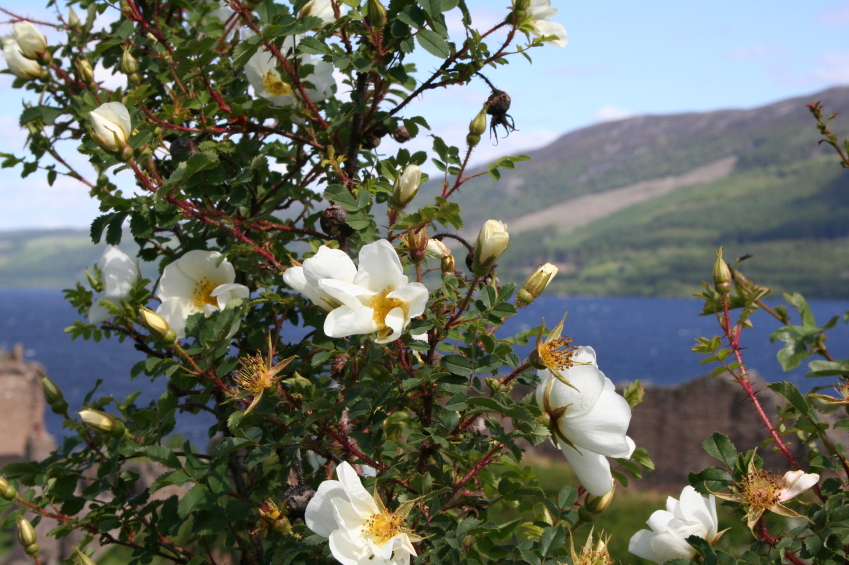
All 69 Scottish Nationalist Party members of parliament wore white roses in their lapels at the swearing in ceremony of the Scottish parliament a few years back and I was recently asked why? The thistle is usually thought to be our national flower. The story of why both of these flowers are connected to Scotland lies in the myths and legends of the past…
Traditionally the thistle is seen one of Scotland’s most enduring symbols and nowadays the thistle seems as Scottish as bagpipes and tartan, so just how did this prickly weed come to symbolise a nation? The answer, as so often is the case, lies in myth and legend…
By the 13th century, the kingdom of Norway controlled much of the western seaboard of Scotland and had done for over 600 years. In 1263 King Alexander III of Scotland tried to regain control of the west, from the Western Isles to Kintyre. King Haakon IV of Norway and an army of Norsemen decided to attack the Scots troops on the west coast of Scotland near Largs. According to the story, their plan was to sneak up on the Scots encampment in the dead of night in order to mount a surprise attack. However one unlucky barefoot Norsemen stood on a thistle, and his cries of pain were enough to waken the Scottish troops and alert them to the danger. The Scots went on to defeat the Norsemen at the Battle of Largs. Haakon retreated in disgrace, and soon after the Norwegian campaign was in tatters. Three years later, with the Treaty of Perth, the Norwegian King renounced any claim to Scotland and the centuries old dispute was over, thanks in part to the humble thistle.
Whether there is any truth in this legend or not, there is no doubt that the thistle went on to become a potent symbol of Scotland and was first used as a royal symbol when it appeared on silver coins issued by James III in 1470.
So what of the white rose? Rosa x alba grows all over Scotland. It is a bushy, shrub like rose with dark, grey green foliage and a small five petalled flower, similar to a dog rose, which can be white or pale pink. They only flower in spring, and have a beautiful scent with notes of citrus. The plants are hardy, thrive in poor soil, can tolerate shade and drought and are for the most part resistant to disease.
The white rose became a symbol of the Jacobite cause, a political movement in the 17th & 18th centuries whose aim was to restore the exiled Catholic King James II and his descendants to the throne of Scotland, England and Ireland. Again the roots of the rose as a symbol are somewhat lost in myth and legend. It is said that one of the earliest references refers to the birth of James Francis Edward Stuart, son of the deposed King James II, who was born on 10th June in 1688, said to be “the longest day of the year in which the white rose flowers”.
In the years leading up to the Jacobite Rebellion of 1745, Jacobites were forced to meet and plot in secret, and the white rose or white cockade (a flower made from ribbon, often worn on a hat) was a way of identifying those who supported the cause. The Jacobites had many other secret symbols, including the sunflower (to symbolise loyalty, as a sunflower always follows the sun) and moths or butterflies (their emergence from a chrysalis symbolised the hope for the return to power of the Stuart family). Another legend tells how Bonnie Prince Charlie plucked a white rose from the roadside and stuck it in his hat as he made his way south from Glenfinnan to start the Jacobite Rebellion of 1745.
Scotland’s First Minister, Alex Salmond, when asked about the significance of the Nationalists wearing of the white rose, denied that the flower was a reference to the Jacobites. Instead he cited the poem “The Little White Rose”, written by the Scottish poet Hugh MacDiarmid, and claimed the rose stood for “all of Scotland”. MacDiarmid (1892-1978) was a committed Nationalist and in 1928 helped found the National Party of Scotland, the forerunner of today’s Scottish National Party.
The Little White Rose
The rose of all the world is not for me
I want for my part
Only the little white rose of Scotland
That smells sharp and sweet – and breaks the heart
The poem refers in its first line to another work, the poem The Rose of Battle by Irish poet WB Yeats, with its opening line “Rose of all roses, rose of all the world“. For Yeats, the rose symbolises many things – beauty, femininity, perfection, Ireland…. MacDiarmid rejects these all of these possible meanings in favour of simply the little white rose of Scotland, vulnerable yet tough, which for MacDiarmid symbolises the country that he loves. I think Hugh MacDiarmid would be delighted to know the words of this little poem are now carved in stone on the walls of the Scottish parliament building in Edinburgh.
Incidentally, one of MacDiarmid’s most famous poems is a long, epic poem written in Scots and entitled “A Drunk Man Looks at the Thistle“. So maybe we can have two national flowers after all.
Related posts
Whoops! No connected account found. Try connecting an account first.

